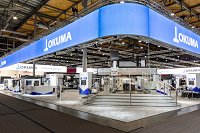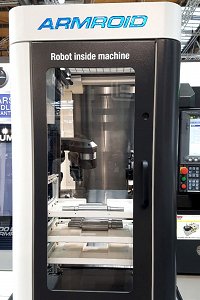Novelties in automation, digitalisation and machining
16.10.2019
With 13 European premieres and a booth of roughly 1,500 m², Okuma, represented in Slovenia by Misan Slovakia s.r.o., displayed a rich portfolio of new technologies at this year’s EMO Hannover. Visitors got to experience the latest machine tools, controls, automation technology and industry 4.0 solutions. Definite crowd-pullers were the large double-column machining centre MCR-S as well as the new robotic solutions ARMROID and STANDROID. With a live demonstration of the Smart Factory solution Connect Plan, visitors could also experience the future of manufacturing.
Innovative robot arm
A clear highlight of the Okuma booth was the revolutionary ARMROID technology. ARMROID is an articulated robot arm directly integrated into the machining area. The arm can autonomously switch its end effector for carrying out various tasks. One end effector is a workpiece hand that allows for easy automation by loading and unloading the machine tool. The second end effector acts like a follow rest and prevents chatter during turning operations by supporting the workpiece. With the third end effector, ARMROID is able to blast the cutting zone with coolant or air to break the chips safely. It can also be used for cleaning the machining area. When the arm is not in use, it is stored compactly, which facilitates operating the machine tool manually without obstructions.
Making automation easy and accessible
Together with ARMROID, Okuma also introduced STANDROID. STANDROID is an articulated robot arm integrated into a cell. As the cell can be placed next to machine tools, requiring only a connection to the network and to electricity, installing STANDROID is far easier than conventional robots. In addition, both ARMROID and STANDROID can be operated like a machine tool, making special trainings for staff unnecessary. Operators only need to define the start and end points of the robot’s motion. The control then calculates the best routes of the robot arm, and the Collision Avoidance System assures safe operations. For around-the-clock automation, Dutch Okuma partner BMO Automation showcased an automation setup at the booth consisting of product drawer modules, a robot and an Okuma machine tool.
The Okuma Smart Factory: Visualise, Analyse, Optimise
 At EMO Hannover, Okuma exemplified how industry 4.0 applications can improve manufacturing processes by connecting every machine tool to Connect Plan. The application visualises the status of every machine on a dash board and provides important information like operator history, error history and maintenance schedules. This allows for an in-depth analysis which enables optimising manufacturing process comprehensively. “One of your clients found that they had frequent downtimes. Investigating further, they found out that these downtimes occurred because the operators were searching for a measuring device. By simply defining a dedicated spot for the measuring device, operators no longer had to search for it and spindle running times increased by roughly 20 %,” said Juergen Klaeser, Senior Manager Application. The collected data also enable Predictive Maintenance. Manufacturers can upload their data to the Okuma Cloud to increase this predictive power even further. As Okuma uses an SQL database for Connect Plan, the data can be analysed with third-party software as well. Depending on the individual needs, the Smart Factory solution provides additional functions like automatic e-mail notifications.
At EMO Hannover, Okuma exemplified how industry 4.0 applications can improve manufacturing processes by connecting every machine tool to Connect Plan. The application visualises the status of every machine on a dash board and provides important information like operator history, error history and maintenance schedules. This allows for an in-depth analysis which enables optimising manufacturing process comprehensively. “One of your clients found that they had frequent downtimes. Investigating further, they found out that these downtimes occurred because the operators were searching for a measuring device. By simply defining a dedicated spot for the measuring device, operators no longer had to search for it and spindle running times increased by roughly 20 %,” said Juergen Klaeser, Senior Manager Application. The collected data also enable Predictive Maintenance. Manufacturers can upload their data to the Okuma Cloud to increase this predictive power even further. As Okuma uses an SQL database for Connect Plan, the data can be analysed with third-party software as well. Depending on the individual needs, the Smart Factory solution provides additional functions like automatic e-mail notifications.
Dies and moulds in one setup
A prominent cornerstone of the trade fair booth was the large double-column machining centre MCR-S. The machine is predestined for the die and mould industry as it combines high productivity, outstanding dimensional accuracy and a high surface quality. With these properties, the MCR-S can rough, finish and fine finish a workpiece in one setup. The machine’s high accuracy relies on a number of hardware and software technologies. One of them is a swivel image sensor that measures the tool’s cutting edge. As a result, tool change related cutting edge offsets can be reduced to less than 10 µm. The outstanding surface quality is achieved with the Intelligent Technology Hyper-Surface. By automatically detecting and correcting errors in the machining data, the application creates extremely smooth surfaces that rarely need manual post-processing. The high manufacturing quality has a positive impact on the machine’s productivity. Pablo Liechti, Product Manager, gave an example, “We have a customer who saves 38 hours in total when machining a large die mould with the MCR-S. They benefit from a shorter finishing cycle, fewer hours spent on polishing and little need for matching the press dies to their counterparts.”





































